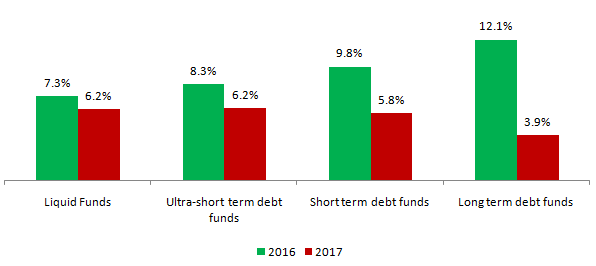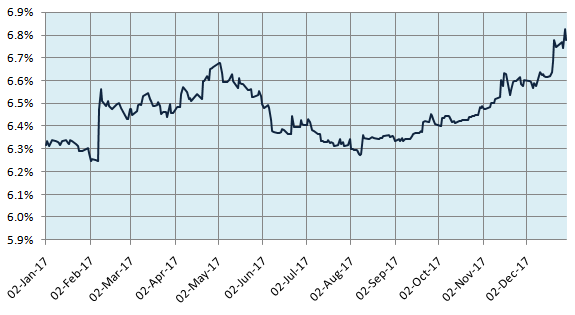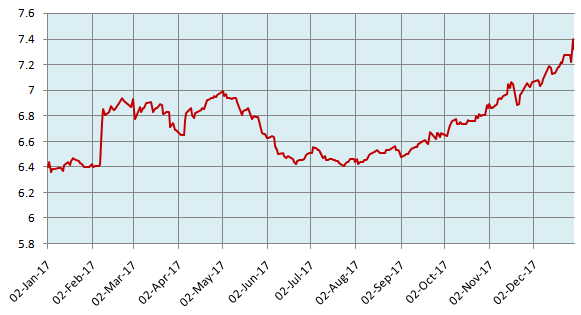How you should invest in debt mutual funds: Short term versus long term

2017 was a great year for the stock market and mutual funds. As per December 2017 AMFI data, industry wide assets under management in equity and balanced funds rose 77% year on year. Even after factoring in value appreciation due to market rally, this show a lot of fresh money has flowed into mutual funds in 2017. This is great news for the mutual fund industry and its various stakeholders; the efforts which the Asset Management Companies and more importantly, mutual fund distributors in different cities and smaller towns across India, put on investor education for the past several years is paying off now.
However, one financial advisor based in Kolkata, expressed his concerns about certain aspects of this growth to me a few weeks back. His concern was related primarily to senior citizen investors. With lower fixed deposit (FD) and Government small savings interest rates, this advisor is getting calls from many senior citizens who want to invest their FD maturity amounts in balanced funds in the hope of getting higher income through dividends. The advisor is worrying that, the next bear market, whenever it comes, may cause a lot of capital erosion and financial stress for senior citizens, who shift the asset allocation from debt to equity. The advisor’s concern is valid because the risk profiles of debt and equity asset classes are very different; equity is a much riskier asset class compared to debt and investors should understand the risks associated with equity before investing.
I told the advisor that FDs and equity or balanced funds are not like to like comparison; he should recommend debt or debt oriented hybrid mutual funds to investors with low risk appetite, especially senior citizens who want to shift their corpus from FDs and small savings schemes to mutual funds. The problem with debt funds, the advisor said was that, investors and even many financial advisors do not have a good understanding of debt mutual funds. Debt fund is a vast and slightly complicated topic. Unlike equity funds, there are many debt fund product categories with their specific risk characteristics.
One of the questions that we often get from investors is which debt fund is suitable for them. There are broadly three types of debt funds – money market mutual funds, short term debt funds and long term debt funds (there are also many sub-categories which are outside the scope for the purposes of this blog post).
Read how to select debt funds by understating the risk
Money market mutual funds like liquid funds and ultra-short term debt funds are very low risk investments, suitable for investment tenure of less than 1 year. For investment tenure of more than one year, investors should consider short term debt funds or long term debt funds. This is where many investors get confused because returns of short term debt funds and long term debt funds can vary a lot from year to year depending on the interest rate environment.
In this two part blog post, we will discuss how short term and long term debt funds work, particularly with reference to debt fund performance in 2017. In the second part of this post, we will discuss which type of debt fund might be suitable for your investment needs.
Debt fund returns in 2017
Before we discuss about short term and long term debt funds, let us recap how debt funds performed in 2017. 2017 was a bad year for debt funds and many investors are likely to be disappointed with their debt fund performance. However, investors should know that 2017 was an exceptional year for bond markets; investors got excellent returns from debt funds just the year before. The chart below shows the average returns of different debt fund categories in 2016 and 2017.

Source: Advisorkhoj Research
You can see that, short term debt funds and long term debt funds disappointed in 2017; returns were lower than FD interest rate. However, if you combine the returns of 2016 and 2017, both these debt fund categories would have beaten FD interest rates over the last 2 years. This is the reality of market linked investments; you have to be prepared for variability in performance.
Let us discuss why short term and long term debt funds underperformed by understanding the basics of bond investing. Bond investors get returns from two sources:-
- Interest paid by the bond (coupon) usually twice a year
- Price appreciation of the bond before maturity
Bond prices are inversely related to interest rates. Some investors have asked me, why bond prices fall even if RBI keeps the interest rate (repo rate) unchanged. While repo rate is an important interest rate for the economy, bond prices depend on demand and supply situation. If the demand for debt is higher than supply, the borrower has to pay more returns to the lender. In the case of bond issuers, higher returns can be realized by paying a higher coupon (interest rate) or by simply reducing the price of the bond (for the same coupon / interest). Return for bond investors for a particular price is known as yield. When yields go up, bond prices fall. This benefits new bond investors, but hurts existing bond investors because they invested in the bond at a higher price. Let us now discuss the difference between short term debt fund and long term debt fund.
Short Term Debt Funds:
Short term debt funds invest in Commercial Papers (CP), Certificate of Deposits (CD), short maturity bonds (Government bonds) and non convertible debentures (corporate bonds). The average maturities of the securities in the portfolio of short term bond funds are in the range of 2 – 3 years. The fund managers employ a predominantly accrual (hold to maturity) strategy for these funds. This means that, the fund managers do not sell the bonds when its price rises or falls, but hold them to maturity to earn interest paid by the bond.Long Term Debt Funds:
Long term debt funds, also known as, income funds invest in a variety of fixed income securities such as bonds, debentures and government securities, across different maturity profiles. For example they can invest in 2 to 3 year corporate non convertible debenture and at the same time invest in a 20 year Government bond. Their investment strategy is primarily duration calls (profiting from bond price appreciation when rates fall), but they can also employ hold to maturity (accrual income) strategy for some bonds in their portfolios. The average maturities of securities in the portfolio of income funds are in the range of 7 to 20 years.
Let us now discuss why short term debt funds underperformed in 2017. The chart below shows the yields trajectory of 2 year Government Bonds in 2017; short term debt funds invest in bonds which mature in 2 – 3 years.

Source: Investing.com
You can see that the yields have been steadily rising from July 2017. Yields have increased almost 50 basis points in the last 5 months; even on a yearly basis bond yields rose almost 50 bps in 2017. For a bond of 2 – 3 year duration, a 50 bps rise in yield can mean a price decline of 1 to 1.5%. So if a bond was paying an annual interest rate (coupon) of 7%, the return of bond in the last 1 year would be 5.5 to 6% only. This explains the underperformance of short term debt funds versus FDs in 2017.
Let us now understand why long term debt funds underperformed even more in 2017. Long term debt funds invest in longer maturity bonds, which are more sensitive to yield changes. The chart below shows the yields trajectory of 10 year Government Bonds in 2017.

Source: Investing.com
You can see that the 10 year Government Bond yields rose almost 100 basis points or 1% in the last 5 months; even on a yearly basis yields rose 1% in 2017. For a bond of 10 year duration, a 1% rise in yield can result in 10% decline in bond prices. So even if a 10 year bond was paying 9% interest rate (coupon), the 1 year returns would be negative. Investors should note that, long term debt funds invest at different points in the maturity spectrum (mix of long term and medium term bonds); that is why they were able to generate positive returns, even though long term bond yields rose substantially.
In the interest of all our readers, a discussion on the macro factors that led to depressed bond market and rising yields in 2017 is outside the scope of this blog post. Investor knowledge aside (we have discussed the various factors which affected bond market in a separate post), 2018 might be a very different year for bonds compared to 2017 because higher bond yields may attract foreign investors to Indian bonds. Let us now discuss some misconceptions regarding long term and short term debt funds.
Some misconceptions regarding debt funds
Before we start talking about the misconceptions regarding debt funds, what about knowing debt mutual funds and their various types
Debt funds are very risky:
Just because debt funds underperformed FDs when equity gave fantastic returns, does not mean that debt funds are as risky as equity. In a bad bear market, equity funds can fall 20% or more. Even in a bad year for bond market like 2017, debt funds were able to generate positive returns. Debt funds are much less risky than equity funds. Further, many debt fund managers employ a flexible investment strategy to safeguard investor interests in different debt market conditions.Short term debt funds have no interest rate risk:
Any debt fund whose, maturity profile is more than a year, will be subject to interest rate risk. As such, even short term debt funds have interest rate sensitivity. However, the interest rate risk is limited compared to long term debt funds, as can be seen based on the relative category performances in 2017.There is no risk in debt funds if RBI keeps rates unchanged:
As discussed in this post, bond yields can change even if RBI keeps rates unchanged. Investors should understand that the Government is the biggest borrower. If the Government of India needs to borrow more to meet its different obligations towards the economy, then bond yields will go higher, bond prices will fall and consequently, debt funds will give lower returns. In an increasingly globalized economy, bond yields in India also depend on bond yields in developed markets like the US. If US bond yields are increasing, then foreign investors are likely to shift their investment from emerging markets to the US Treasury Bonds, which is a much safer asset for them. Similarly, if the dollar is strengthening versus emerging market currencies, foreign investors will divert their funds to the US. To attract foreign investments, Indian bond yields have to rise and this may hurt existing bond investors.Long term debt funds need market timing:
It is true that, if you time you long term debt fund investments at the top of the interest rate cycle, you can get excellent returns. However, market timing is not a necessary condition to get good returns from long term debt funds. The yield curve is usually upward sloping, which means that long term bonds give higher yields than short term bonds (we will discuss this in greater details in Part 2 of this post).
If you have a long investment horizon then, you can benefit from the higher yield over long investment tenure and also from the fact that, over a long investment tenure interest rate or yield cycles reverse, meaning that you will have periods of both rising rates and falling rates. So while rising rates will cause prices to depreciate, falling rates will cause prices to appreciate.Long term debt funds will always outperform short term debt funds in the long term:
For some debt fund investors this may come as a surprise, but long term debt funds do not always outperform short term debt funds in the long term. The definition of long term can be quite subjective and vary from investor to investor. From a debt fund perspective, let us assume that, 3 to 5 years investment tenure is long term. In the last 3 years, short term debt funds gave 7.9% annualized returns while long term debt funds gave 7.4% annualized returns; in the last 5 years, short term debt funds gave 8.3% annualized returns while long term debt funds gave 8% annualized (source: Advisorkhoj research). Over both time-scales, short term debt funds outperformed long term debt funds by varying margins. In Advisorkhoj’s view, over very long term, the relative performances of short term and long term debt funds actually evens out, with no significant advantage to either category.
You may like to read this as well – How to select debt funds: modified duration and volatility
Conclusion
In the first part of this two part blog post, we discussed how debt funds performed in 2017, the difference between short term debt funds and long term debt funds, and tried to explain the relative performances of these two debt fund categories in 2017. We also clarified some misconceptions regarding these two types of debt funds. In the next part of this blog post, we will discuss how to choose between short term and long term debt funds.
Mutual Fund Investments are subject to market risk, read all scheme related documents carefully.
RECOMMENDED READS
Sundaram Asset Management Company is the investment manager to Sundaram Mutual Fund. Founded 1996, Sundaram Mutual is a fully owned subsidiary of one of India's oldest NBFCs - Sundaram Finance Limited.
Quick Links
- Interview - Mr. Dwijendra Srivastava - CIO - Fixed Income
- Interview - Mr. Sunil Subramaniam - CEO
- Sundaram Select Midcap Fund: Consistent outperformance makes it a big wealth creator
- Interview - Mr. Sunil Subramaniam - CEO
- Fund Manager Interview - Mr. Krishna Kumar - CIO - Equities
- Sundaram Rural India Fund: This thematic Mutual Fund aiming good long term returns
- Sundaram Equity Multiplier: Long term wealth creation potential
- Our Articles
- Our Website
- SIP one sheeter-Investor Education initiative
- Sundaram Asset Management Singapore
- Returns Calculator
- SEBI Investor Awareness Initiative
- Check your KYC Status
- KYC Forms & FAQs
- Recieve your PIN
- A note on NIGO
- FAQs on RGESS
- FAQs on Direct Plan
- Receive Updates
- Share your views
- Transmission Checklist
- Equity Application Form
- Fixed Income Application Form
- Transaction Slip
- Factsheet May - 2016
- MF Tax Reckoner 2015
Follow Sundaram MF
More About Sundaram MF
POST A QUERY




